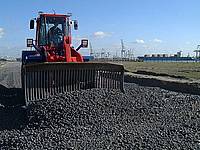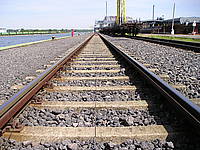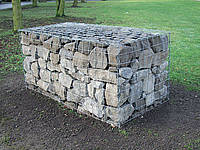Unbound applications
Unbound use includes a wide variety of applications in civil engineering works, road works and hydraulic works.
| Application | Description | GBS | ABS | STEEL SLAG |
|---|---|---|---|---|
| Unpaved roads | durable surface layer for trafficked areas, | |||
| Constructional layer (base layer, sub-base layer and sub-grade layer) | bearing layer to support the pavement (asphalt, concrete or blocks) and to conduct and divide traffic load to the subsoil, | |||
| Non-constructional layer (embankment and fill) | non-bearing layer or body, | |||
| Armourstone | very coarse aggregate for filter layers, ballast layers, erosion control, etc. in hydraulic works, | |||
| Gabions | caged coarse aggregate for retaining walls, erosion control, noise absorbing walls, etc., | |||
| Railway ballast | coarse aggregate layer upon which railway sleepers are laid, | |||
| Roofing | coarse aggregate layer to ballast the roof or fine aggregate on bituminous sheets. |
Because of the rough surface and angular shape of the grains and high resistance to mechanical forces, iron and steel slag aggregates are very suitable for unbound applications, especially when a mechanically stable construction is needed. Because this slag slowly hardens in time due to its hydraulic properties and/or carbonation, the stiffness of layer increases in time. This increases the life of a road surface and decreases the need for structural maintenance.
Because of the rough surface and angular shape of the grains and high resistance to mechanical forces, iron and steel slag aggregates are very suitable for unbound applications, especially when a mechanically stable construction is needed. Because this slag slowly hardens in time due to its hydraulic properties and/or carbonation, the stiffness of layer increases in time. This increases the life of a road surface and decreases the need for structural maintenance.
In the case of armourstone (with grain sizes up to 250 mm), steel slag is often used, because of its high density which is much higher than most natural aggregates.
For the use in unbound layers, the slag aggregate has to fulfil the requirements of EN 13242. In the case of armourstone the requirements of EN 13383-1 and for the use as railway ballast the requirements of EN 13450 must be fulfilled.



